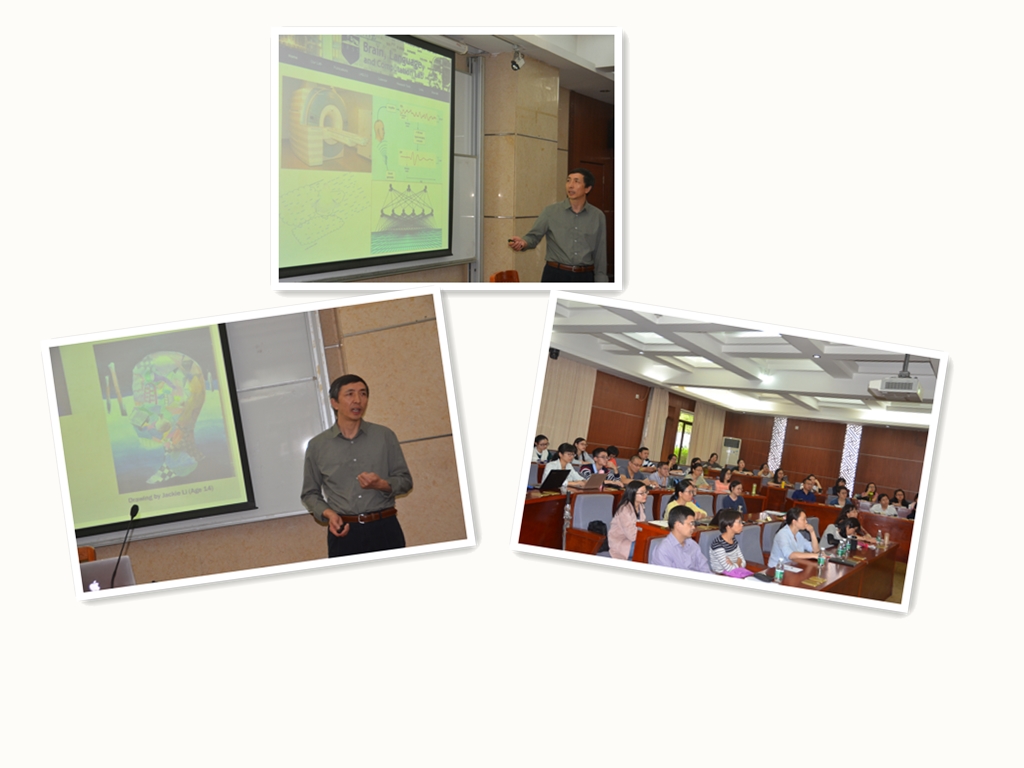2017年11月13日下午,我们邀请美国宾夕法尼亚州立大学脑、语言与计算实验室主任李平教授作题为“二语学习如何重塑大脑”的讲座。
李平教授首先向我们展示了新学习科学作为了解大脑复杂性技术的宏观图景。具体来说,新学习科学由四个相互关联的学科组成:心理学、认知科学、机器学习及教育学。双语作为一个动态的加工过程能够塑造大脑,因而目前关于双语的心理语言学研究已逐渐成为显学,具体的研究方法包括计算机模拟、脑电以及功能性磁共振成像技术。李教授以动态的视角探讨二语学习,具体来说,通过短时训练及跟踪研究主要着眼于四大方面:大脑标记(功能连通性及结构变化)、个体差异(工作记忆与认知控制)、学习环境(传统与3D虚拟环境)及年龄效应(儿童及成人早晚期的学习)。短期及长期的二语学习都能导致大脑功能及结构上的改变。在一个短期声调词汇训练的功能性磁共振成像研究中,他的团队发现了较成功的学习者比一般学习者具有一个更协调的多通路脑网络。二语学习者的纵向跟踪研究也表现出类似的模式。在另一个探索二语学习者词汇加工神经联结的研究中,他们通过在一个学年中对于被试进行前后测,发现被试大脑中控制区域(如前扣带回)激活程度减少,而语义加工相关区域(如颞中回)连接程度增加。在讲座的后半部分,李教授对比了传统的联想式学习以及运用3D技术的虚拟学习,后者作为具身体验能够促进二语词汇习得,尤其是在学习中后期。最后,他总结道:1)学习能够迅速导致大脑功能及结构上的变化,这一动态变化受不同因素的影响;2)大脑网络分析能够预测学习中的个体差异;3)3D数码技术的学习环境能够产生有益的、持续性的大脑变化。
在问答部分,李教授与听众就虚拟/增强现实研究的运用及前景进行了热烈的讨论。
Professor Ping Li, director of the Brain, Language, and Computation Lab at the Penn State University, was invited to deliver a lecture entitled “How Second Language Learning Remodels the Brain” on the afternoon of Nov.13th , 2017.
Prof. Li first presented a general picture of the new science of learning as a window into the complexity of the brain, which consisted of four interrelated disciplines, i.e., psychology, neuroscience, machine learning and education. Bilingualism as a dynamic process could help sculpt the brain; therefore, the psycholinguistics of bilingualism had come to the fore with research methods like computer modelling, ERP and fMRI techniques. Prof. Li then tried to approach the study of L2 learning with a dynamic view. Specifically, L2 learning was studied by short-term training or longitudinal tracking from four perspectives, viz. brain signatures (functional connectivity and structural changes), individual difference (working memory and cognitive control), learning context (traditional vs. 3D virtual environment) and age effects(early vs. late learning in children and adults). The functional and structural changes of the brain induced by L2 learning was reflected in both short-term and long-term learning. In a short-term novel tonal vocabulary training research using the fMRI technique, his team found that compared to less successful learners, successful ones showed a more coherent and integrated multi-path brain network. A similar pattern occurred in the longitudinal tracking of L2 learners. In the study which examined the neural correlates of lexical processing in L2 learners twice over the course of one academic year, they discovered that overall activation in control areas such as the anterior cingulate cortex decreased while connectivity with semantic processing regions such as the middle temporal gyrus increased. In the second half of the talk, Prof. Li made a contrast between traditional associative learning and 3D virtual learning. 3D virtual environments as embodied experiences provided an important facilitatory platform that enhanced second language vocabulary acquisition, especially for later stages of learning. He concluded that 1) learning could rapidly cause functional and structural brain changes which reflected dynamic patterns; 2) individual differences in learning could be identified by brain network analysis; 3) 3D digital technology-based contexts of learning could lead to better and sustained brain changes.
During the Q & Asession, Prof. Li had an animated discussion with the audience about the application and prospect of virtual/augmented reality studies.

